Physical Address
304 North Cardinal St.
Dorchester Center, MA 02124
Orthopaedic surgery involves the assessment and management of a wide spectrum of common conditions that affect bones, joints and soft tissues. The focus of this chapter is the assessment and management of degenerative and inflammatory joint diseases; bone and joint infection; congenital and developmental (growing skeleton) conditions; soft tissue and bone tumours; and trauma. Assessment almost always begins with history and examination, and is frequently followed by imaging.
A diagnosis can often be made with history alone. The cardinal symptoms of the musculoskeletal system are pain, swelling, redness, heat, loss of function and weakness. It is important to determine the onset of these symptoms and their nature: acute versus chronic, monoarticular versus polyarticular, small versus large joints and precipitation factors (e.g., medications, trauma). Red flag symptoms are important to exclude if any sinister diagnosis is contemplated. Summary 28.1 Summary 28.2
This often distinguishes degenerative conditions (elderly) from those related to an underlying congenital, birth-related or developmental problem (young) and different types of bone tumours. Back pain could be due to disc prolapse or ankylosing spondylitis in younger adults or due to metastasis or degenerative spondylosis in the elderly.
There may be a direct link between events around the time of birth and conditions such as upper limb weakness (traction injury to the brachial plexus), cerebral palsy (hypoxia) and dysplastic disease of the hip (more common in a breech delivery or first child). Abnormalities in the development of the growing skeleton may result in a range of conditions, some of which are associated with visible deformity. Sometimes, such apparent deformity is just a stage of normal development. For example, some children go through a phase of being bow-legged, and anxious parents need to be reassured that this is a normal physiologic variation and not a disease.
This is particularly relevant to upper limb conditions and has a bearing on the management of upper extremity disorders.
Degenerative processes may be a consequence of, or at least exacerbated by, occupation or repetitive strain injuries, which can occur in certain occupations. The need to return a patient to employment or a certain skill will also greatly affect the way and urgency with which a condition is treated.
Many conditions follow a clearly defined episode of trauma, the nature and mechanism of which can help establish the diagnosis. For example, a sudden twisting injury to the knee, with acute swelling followed by instability, is highly suggestive of anterior cruciate ligament (ACL) rupture. It is important to ascertain that the history of trauma is significant as some patients associate trauma with the onset of symptoms of diseases such as tuberculosis (TB) and bone tumours.
The condition may have been treated in primary care by means of physiotherapy, acupuncture, osteopathy, steroid injection and drugs over many years prior to referral to an orthopaedic surgeon. Previous surgical interventions performed on the same joint or limb (including those performed during childhood) may affect both the current options for surgery and chance of success.
If operative intervention is planned, general fitness for anaesthesia and surgery must be carefully assessed and the patient medically optimised. The consequences of other comorbidities must be considered.
Regarding analgesia, changing the dose or preparation may result in significant relief of symptoms. Drugs such as warfarin or antiplatelet medication may need to be stopped prior to surgery. Some immunosuppressive drugs increase the risk of infection; smoking and nonsteroidal anti-inflammatories can slow bone healing.
Examination should include all the other systems (e.g., cardiovascular, neurologic, skin), as well as the specific limb and joint. Café au lait spots of neurofibromatosis may be associated with congenital pseudoarthrosis of the tibia or scoliosis. Musculoskeletal examination should always involve look, feel and measuring both passive and active movement after assessing for any joint deformity. It is vitally important to assess the joint above and below and check limb alignment, as hip pathology can present with knee pain and hind foot pathology may be exacerbated by a varus or valgus knee.
In lower limb conditions, observe the patient’s use of a walking stick, their ability to get out of a chair unaided and their gait. Observe any joint or limb asymmetry, muscle wasting, scars, sinus, skin colour changes, misalignment or shortening. The patient may voluntarily assume the position of a joint at a particular angle, which may not necessarily be a fixed deformity. A joint deformity is present only if opposite movement is not possible. Therefore it is better to refer to the position of the joint on observation as an attitude rather than a deformity. An attitude of flexion, adduction and internal rotation of the hip with apparent shortening would be present in a posterior dislocation of the hip joint ( Fig. 28.1 ).
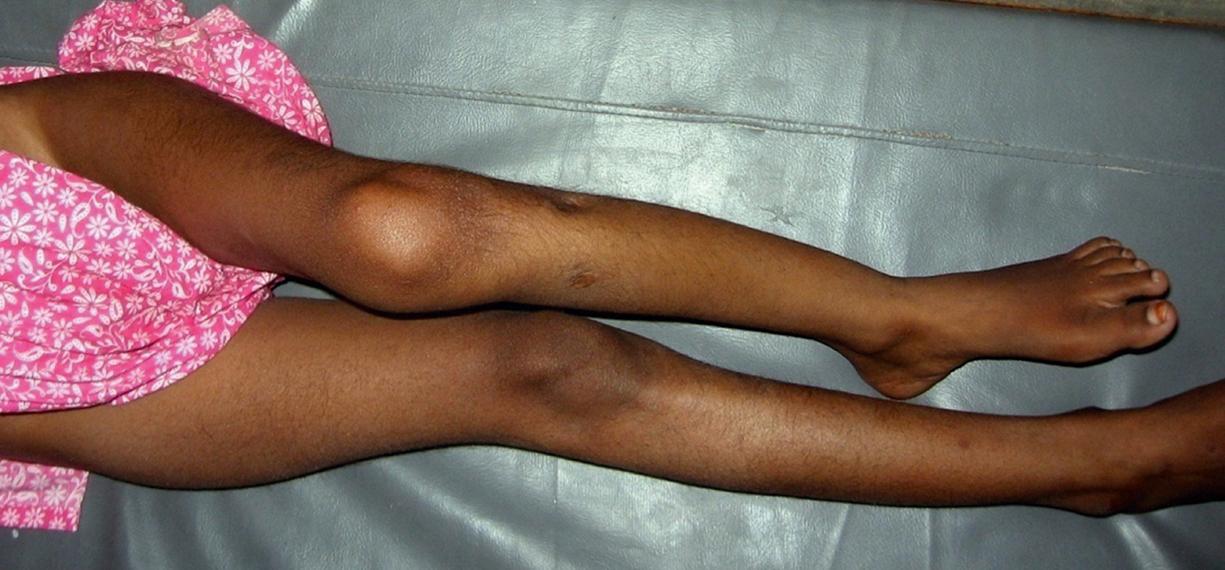
Palpate around the joint or limb. Establish areas of tenderness and try to relate these to anatomic structures (e.g., tendons, joint lines, etc.). Establish the presence of any swelling and whether this is fluctuant or solid ( Table 28.1 ). A thickened irregular bone associated with a puckered adherent scar or discharging sinus could be diagnostic of underlying osteomyelitis ( Fig. 28.2 ), whereas a thickened irregular bone spur on the joint line of a stiff knee is more likely to be an osteophyte.
| S | Size | Shape | Surface |
| C | Colour | Consistency | Contour |
| T | Temperature | Tenderness | Transilluminable |
| F | Fluctuance | Fixity | Fields |
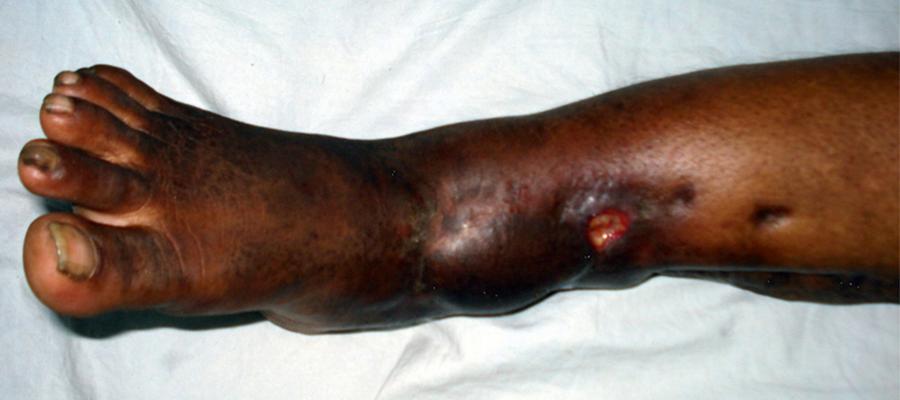
A detailed neurologic assessment is important in spinal disorders. Test the neurovascular status of the limb (motor power, sensation to light touch and pinprick, deep tendon reflexes and peripheral pulses) and compare this to the other side.
Ask the patient to actively move the affected part through a full range of movement, check for any deformity in the joint and observe for limitations of movement, pain or apparent weakness.
Some deformities may not be obvious, for example, a flexion deformity of the hip may be missed due to a compensatory lumbar lordosis ( Fig. 28.3 ). Thomas test is performed to reveal flexion deformity of the hip. On flexing the uninvolved opposite hip to obliterate the lumbar lordosis, the pelvis becomes tilted, thereby revealing the flexion deformity. Similarly, abduction and adduction deformities of the hip may be missed due to tilting of the pelvis and scoliosis. After recording the deformities, move the joint passively through its full range of movement, stopping in response to pain, stiffness or crepitus. Test the power of relevant muscles and apply stress tests to the ligaments, looking for instability.

There are specific provocative tests for most joints that are performed depending on the initial findings. Examples include testing for shoulder impingement (Hawkin test), asking the patient to stand on one leg to test the power of the abductor muscles of the hip (Trendelenburg test) and stressing the ACL of the knee to look for a rupture (anterior drawer test).
With patients in the anatomic position (i.e., lying on their back with their palms pointing up to the ceiling), limb deformities are described relative to the midline. When the distal part of the limb or deformity is away from the midline, it is termed valgus, and when it is towards the midline, it is referred to as varus. For example, when the ankles are away from the midline, there is a genu valgum or a knock-knee deformity ( Fig. 28.4 ). In a genu varum or bow-leg deformity, the knees are away, but the ankles are towards the midline. It is possible to have genu varum on one side and genu valgum on the other limb, known as a windswept or tackle deformity. Hyperextension of the knee joint is known as recurvatum ( Fig. 28.5 ).
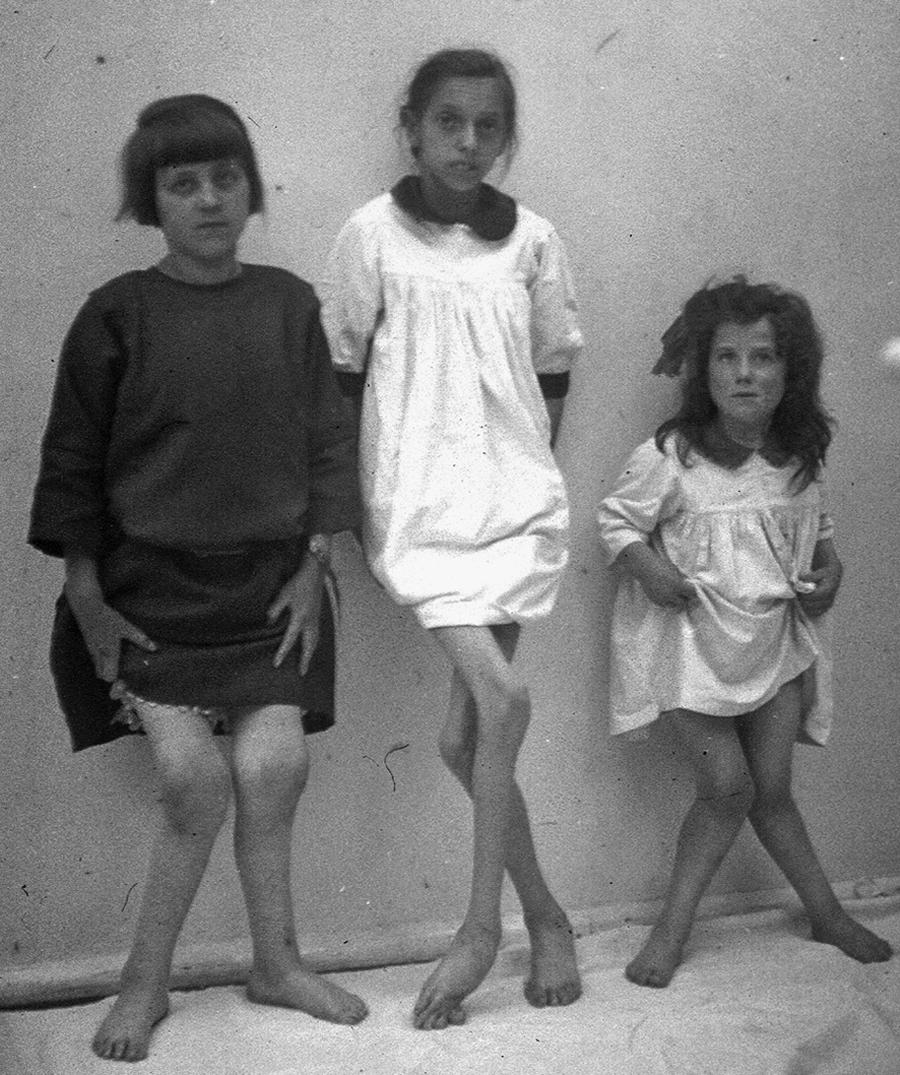
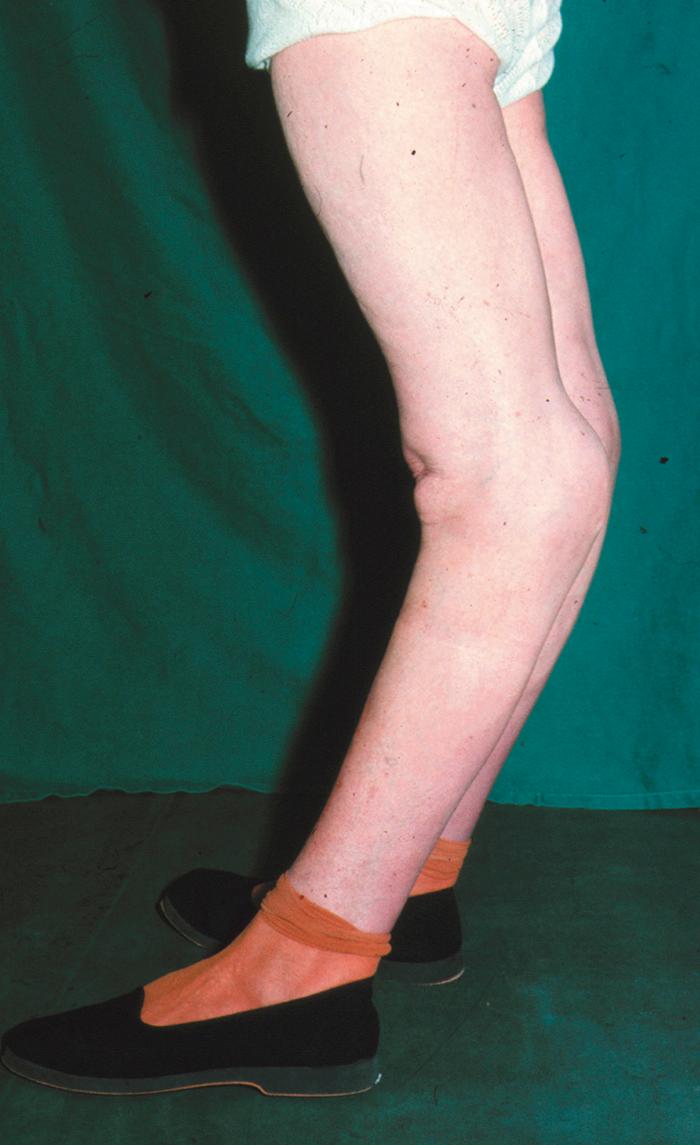
The three types of spinal deformity are:
Kyphosis: forward flexion (‘the kyphotic kisses his knees’) or hunchback
Lordosis: the opposite, extension or bent-over-backwards deformity; this represents the normal alignment of the lumbar and cervical spine
Scoliosis: a sideward deformity that is normally associated with a degree of rotation
Two views in orthogonal planes including the joint above and below are generally used to evaluate almost all bone pathology and are performed while weight-bearing whenever possible. Oblique views are used for fractures of the scaphoid or acetabulum and are also performed to look for spondylolysis of the spine due to any break in the pars interarticularis, which may result in slippage of the vertebrae (spondylolisthesis). Alignment (the degree of varus or valgus deformity), as well as true bone length, can be quantified. X-rays are also used routinely to confirm the correct alignment of bones, joints or prostheses after surgery.
This is frequently used to evaluate soft tissue pathology (e.g., tendon rupture, bleed into soft tissues, joint fluid, other muscular or tendinous pathology) and to guide biopsy or injection. As a dynamic technique, it can be used to visualise the movements of tendons and muscles under direct vision.
These are used to evaluate nerve entrapment syndromes such as carpal tunnel or cubital tunnel syndrome, nerve injuries, neuropathies and abnormalities of muscular contraction.
Computed tomography (CT) provides excellent images of bone anatomy ( Fig. 28.6 ) and can be used to provide three-dimensional (3D) images or printed models to help better visualize the bony anatomy in the reconstruction of complex fractures or the planning of joint replacements. The thin axial slices are particularly useful as a guide for obtaining biopsy specimens.
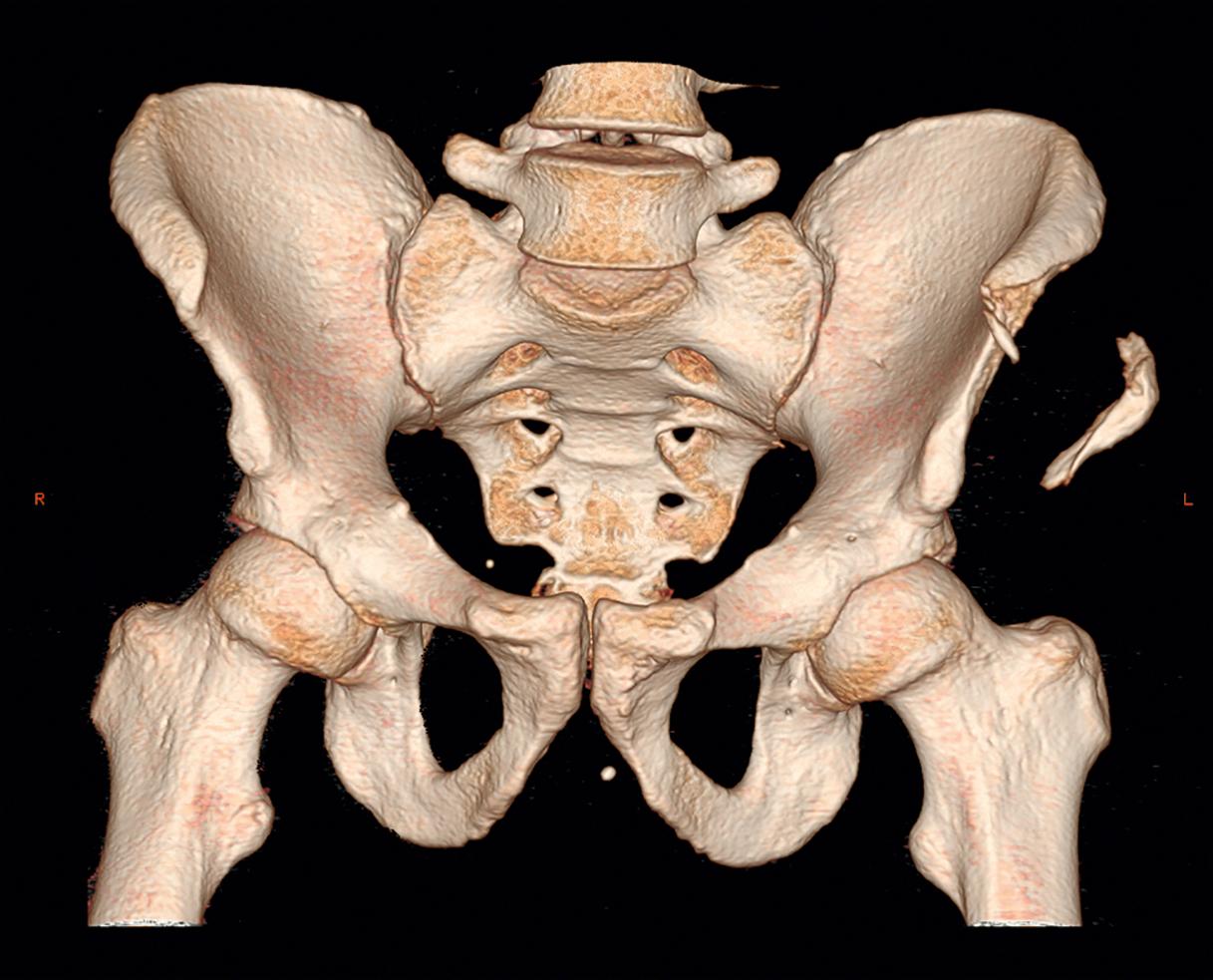
Magnetic resonance imaging (MRI) provides excellent images of soft tissue, joint ( Fig. 28.7 ) and bone pathology without exposure to radiation. It is widely used in virtually all branches of orthopaedics, being especially useful for diagnosis of meniscal and ligamentous injuries of the knee joint, musculoskeletal infections, in determining the extent of tumours and for preoperative planning.
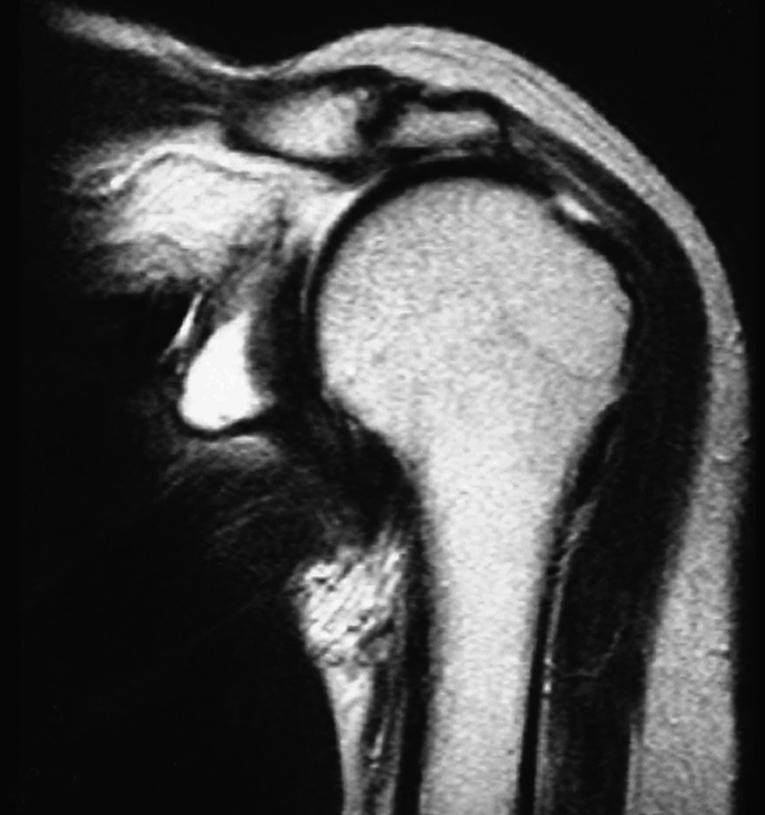
These can be used to assess several bone conditions, including infection and tumours ( Fig. 28.8 ). A DEXA scan is used to quantify osteoporosis in the elderly and postmenopausal women. A SPECT CT is a nuclear medicine scan combined with a CT to give further diagnostic information in difficult cases.
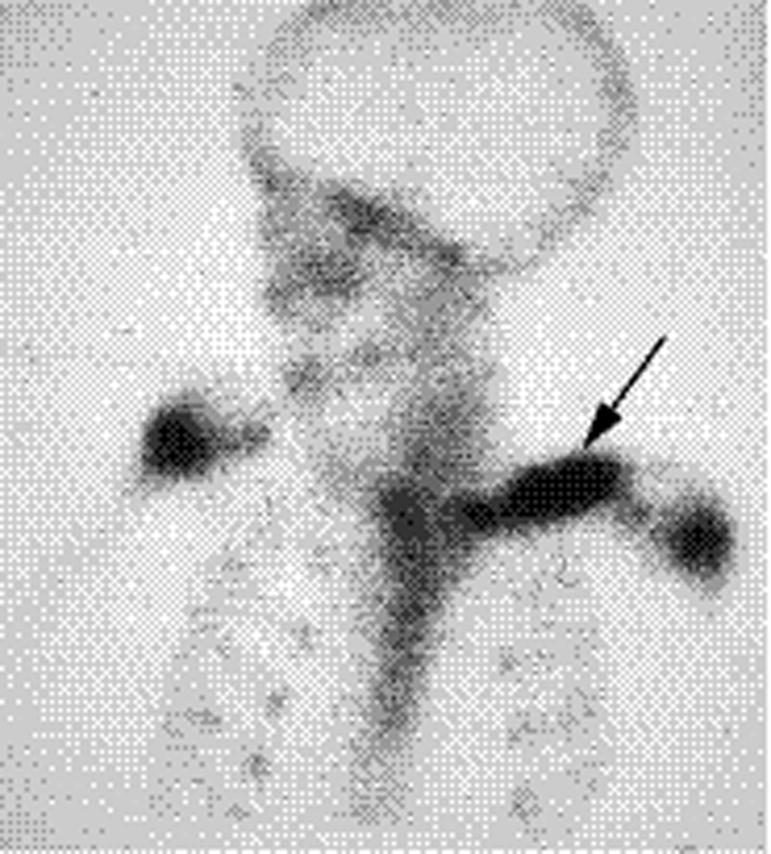
Osteoarthritis (OA) of a joint may occur as a primary idiopathic condition or secondary to problems such as malalignment, intraarticular fractures or overstressing (obesity, overuse). In some patients, there is a strong genetic component. OA may occur in any joint (shoulder, elbow, wrist and hands) but predominantly affects those that are weight-bearing (hip and knee). Idiopathic OA is generally of slow onset and affects the elderly. Secondary OA can affect the young and may develop quite rapidly when a joint injury leads to loss of articular cartilage. On plain x-ray ( Fig. 28.9 ), OA is associated with:
Joint space loss due to thinning of articular cartilage
Sclerosis of the joint surface, with the development of increased density of the bone just under the joint space
Osteophytes
Cystic change
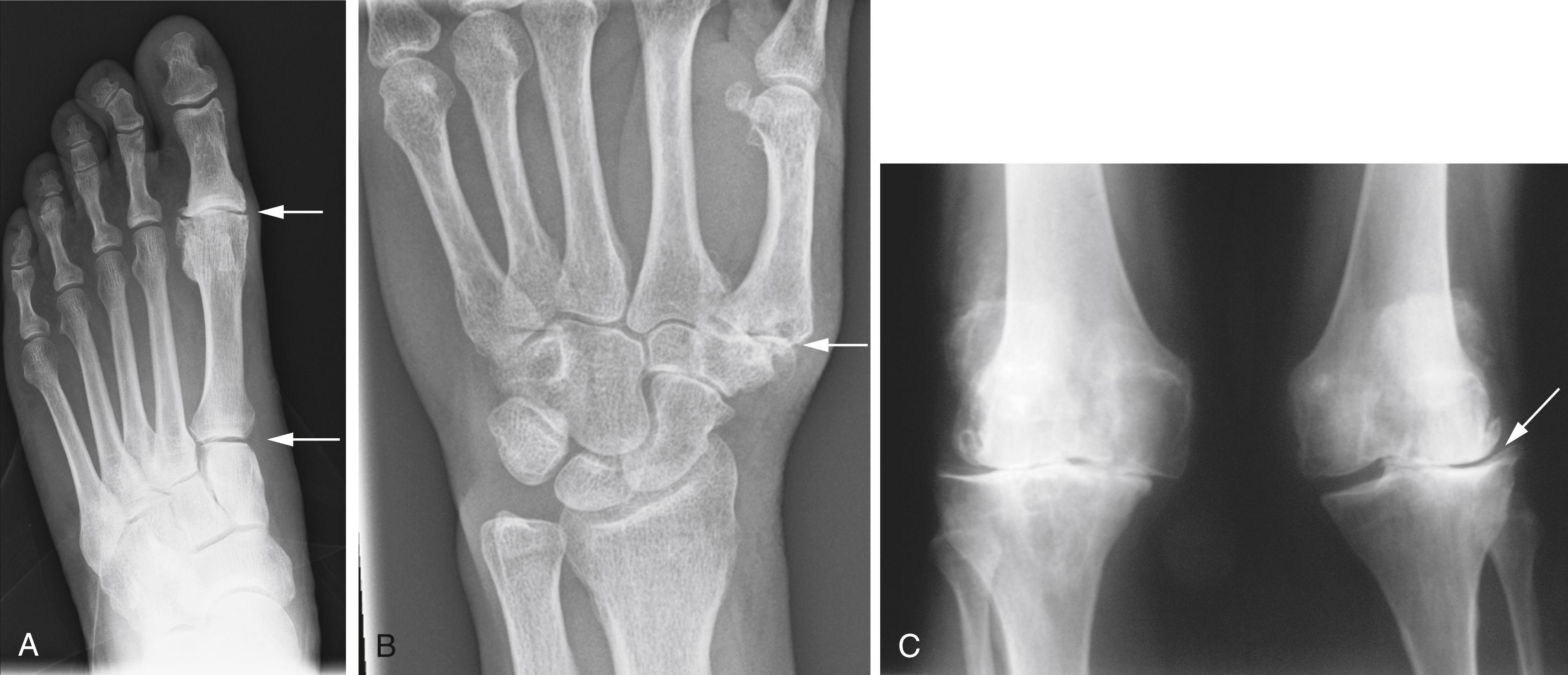
The treatment of OA may be conservative or operative ( Table 28.2 ). The former focuses on the use of drugs and physical methods of pain and stress relief to the joint.
| Nonoperative | Operative |
|---|---|
| Analgesia | Osteotomy |
| Physiotherapy | Joint debridement |
| Orthotics | Excisional osteotomy |
| Injections | Joint replacement (arthroplasty) |
| Lifestyle modifications | Joint fusion (arthrodesis) |
Simple analgesics, such as paracetamol with or without the inclusion of nonsteroidal antiinflammatory drugs (NSAIDs), are the mainstay of treatment. More powerful analgesics, such as codeine or morphine, may be introduced if simple analgesics prove inadequate.
This involves the use of aids, such as a walking stick and weight loss, aimed at reducing the forces passing through the joint. In the obese, weight loss is extremely helpful as the load across a joint can be as high as three to six times body weight. Various insoles and braces are commonly used to off-load joints and are fitted by an orthotist.
Introducing a mix of a corticosteroid and local anaesthetic into the joint may reduce inflammation and ease pain. Injections of compounds of hyaluronic acid are designed to supplement the natural joint levels of hyaluronic acid essential to normal functioning of articular cartilage. They have a limited role and probably work best in early OA.
Physiotherapy and hydrotherapy both have a part to play in the control of symptoms, especially in early disease. Building up lost muscle bulk (due to reduced activity) provides the joint with an increased degree of muscular control and may lead to considerable symptom improvement. Other treatment modalities, such as acupuncture, heat treatment, topical therapy and osteopathy are recognised to have a role in the management of pain associated with OA.
The main operative interventions include osteotomy, joint replacement (arthroplasty) and fusion of the joint (arthrodesis). These procedures are described in the section on orthopaedic procedures.
Rheumatoid arthritis (RA) is the most common chronic inflammatory disease. It affects all ethnic groups, and the peak incidence is in women between the ages of 30 and 50 years.
The pathogenesis of RA is not fully understood, but it is currently thought that genetically susceptible individuals develop the disease in response to an unidentified, possibly infectious, trigger that induces an immune activation and cross-reactivity with endogenous antigens, leading to chronic inflammation in the joints and other tissues. There is a strong genetic association with HLA-DR4 and DR1. Smoking is associated with more severe disease.
Characteristic clinical features of RA are symmetrical joint pain, stiffness and swelling affecting the small joints of the hand and feet, wrists, elbows and knees. There is usually early morning stiffness with synovial swelling and hypertrophy. Distinctive changes seen on radiographs include soft tissue swelling, periarticular osteoporosis, symmetrical joint space narrowing, juxtaarticular erosions/osteopenia and joint subluxation/dislocation leading to deformity.
Cervical spine involvement occurs at the atlantoaxial joint resulting in possible instability. Awareness of this is important for anaesthetists during endotracheal intubation. Extraarticular and systemic features include fever, fatigue, weight loss and anaemia. Diagnosis is usually based on clinical findings along with blood tests (normocytic anaemia, raised erythrocyte sedimentation rate [ESR] and C-reactive protein [CRP], rheumatoid factor positive in 75% of patients) and radiographs. Early diagnosis and start of disease-modifying antirheumatic drugs (DMARDs) may prevent destruction of joints and deformities. In resistant cases, biological therapy (anti-TNF [tumour necrosis factor] or anti-B-cell therapy) may be used.
Surgery is indicated for progressive disease resistant to medical management and ranges from tendon repair or reconstruction, synovectomy, joint replacement or arthrodesis.
Ankylosing spondylitis is a chronic inflammatory disorder characterised by inflammation of the sacroiliac joints and spine, ultimately leading to spinal fusion. The onset is usually during young adulthood (age 20–30 years), and the disease is more common in men (3:1). Clinical features include early morning lower back pain and stiffness, which improves with exercise. Diminished range of spinal movement in all directions leads to characteristic stooped posture with loss of lumbar lordosis, hyperextension of the neck and flexion of the hips and knees. There is variable involvement of peripheral joints and nonarticular structures.
Diagnosis is usually made clinically, but 90% of patients are positive for the HLA-B27 antigen. Characteristic findings on x-ray of the spine include ligament calcification (syndesmophytes) with bony ankylosis resulting in a ‘bamboo spine’ appearance. MRI can be used for diagnosis in the early stages.
These patients should be referred and managed jointly with a rheumatologist. Treatment usually consists of pain relief with antiinflammatories and physiotherapy, with a specific focus on back exercises. In cases of resistant disease, DMARDs or anti-TNF therapy are considered. Surgery can involve joint replacement and, in the case of significant spinal deformity, a spinal osteotomy may be considered.
Infection of the bone and its marrow is known as osteomyelitis (osteo = bone, and myelitis = inflammation of marrow). Osteomyelitis is common in tropical areas and is caused by haematogenous transmission of microorganisms.
Primarily a disease of childhood, these infections present with acute pain, swelling, loss of function (reluctance to use the limb, presenting as pseudoparalysis) and often follow a bout of respiratory or skin infection. The infection begins at the metaphyseal ends of long bones, commonly of the lower limb. In children, 90% of cases are due to Staphylococcus aureus. By contrast, adults may present with rare and unexpected organisms due to other comorbidity, HIV, immunosuppressant therapy, indwelling prosthetic material (e.g., renal dialysis catheters) or intravenous drug abuse.
The diagnosis can be made on clinical suspicion, but MRI has a high sensitivity and specificity. The importance of obtaining blood cultures, aspirations or bone samples prior to starting antibiotics cannot be overemphasised. X-rays may be normal in the first 1 or 2 weeks but later show periosteal reaction.
Treatment for acute osteomyelitis involves urgent admission and commencement of intravenous antibiotics for 2 weeks followed by oral therapy for a total duration of 6 weeks.
Persistent bone infection despite treatment can lead to chronic osteomyelitis. This may be due to poor antibiotic delivery to necrotic bone or antibiotic-resistant microorganisms, particularly in patients with prosthetic implants. Eventually the pieces of dead bone are surrounded by infected granulation tissue and separate from the host bone to form sequestrum. There is an attempt by the host to form new bone or involucrum because of the periosteal reaction. The sequestrum acts as a reservoir of infection and may lie dormant for many years before reactivating. Underlying pus may come out through the involucrum creating channels or cloacae eventually discharging out of the skin, forming a sinus.
Clinically, a palpable thickened, irregular bone with discharging sinus whose tract is fixed to the underlying bone is diagnostic of chronic osteomyelitis. The treatment of chronic osteomyelitis is a combination of long-term antibiotic treatment, pain relief and lifestyle changes (e.g., smoking cessation) along with surgery. Surgery usually involves drainage and ‘sequestrectomy’ of the devitalised dead pieces of bone followed by reconstruction.
Acute haematogenous pyogenic infection of the joint usually occurs in infants. The hip is the most involved joint. High-grade fever and swelling around the joint with loss of limb function distal to the joint are the common clinical features. However, children may only present with an unexplained limp. Inflammatory markers (C-reactive protein and ESR) along with white cell count are usually elevated. An ultrasound scan, particularly of the hip in children, is helpful to look for an effusion before proceeding to aspiration. In most cases, aspiration of pus from the joint confirms the diagnosis, necessitating a formal arthrotomy to drain the pus. If less obvious, the fluid should be sent for urgent Gram stain before commencing antibiotics. Intravenous antibiotic cover for the initial 2 weeks followed by oral antibiotics for a total duration of 6 weeks is the usual treatment.
TB is prevalent in certain developing countries and is of concern in developed countries due to HIV infection immunosuppression. Patients often present with low-grade fever, evening rise of temperature and loss of appetite and weight, along with signs and symptoms of the part affected.
The most common site of musculoskeletal TB is the spine (‘caries spine’) followed by involvement of large joints, although any joint can be involved. The treatment of TB, as recommended by the WHO, includes 6 to 9 months of chemotherapy with a combination of drugs given as an initial intensive phase of 2 months and a subsequent continuation phase. First-line drugs include isoniazid, rifampicin, ethambutol and pyrazinamide, of which the first two drugs are not withdrawn during the continuation phase.
Patients with spinal TB (‘Pott spine’) present with pain, muscle spasm and have different presentations in different regions of the spine. Patients with cervical spine involvement can present with torticollis or may support their chin on their hands (Rust sign). Thoracic spine caries may have a military attitude while lumbar spine involvement may have a lordotic (Alderman) gait.
Spinal TB most commonly affects the anterior part of the vertebral bodies adjacent to a common intervertebral disc, the area having a common blood supply ( Fig. 28.10 ). Collapse of the anterior part of the vertebral body due to the destructive pathology may lead to a kyphotic deformity. Neurologic deficits (‘Pott paraplegia’) usually result from involvement of the midthoracic spine where the spinal canal is narrow. The ‘cold abscess’ formed in spinal TB tracks away from the deep-seated underlying pathology along planes of least resistance such as the neurovascular bundle or fascia covering muscles. It is therefore not as red, warm and tender as a pyogenic abscess.
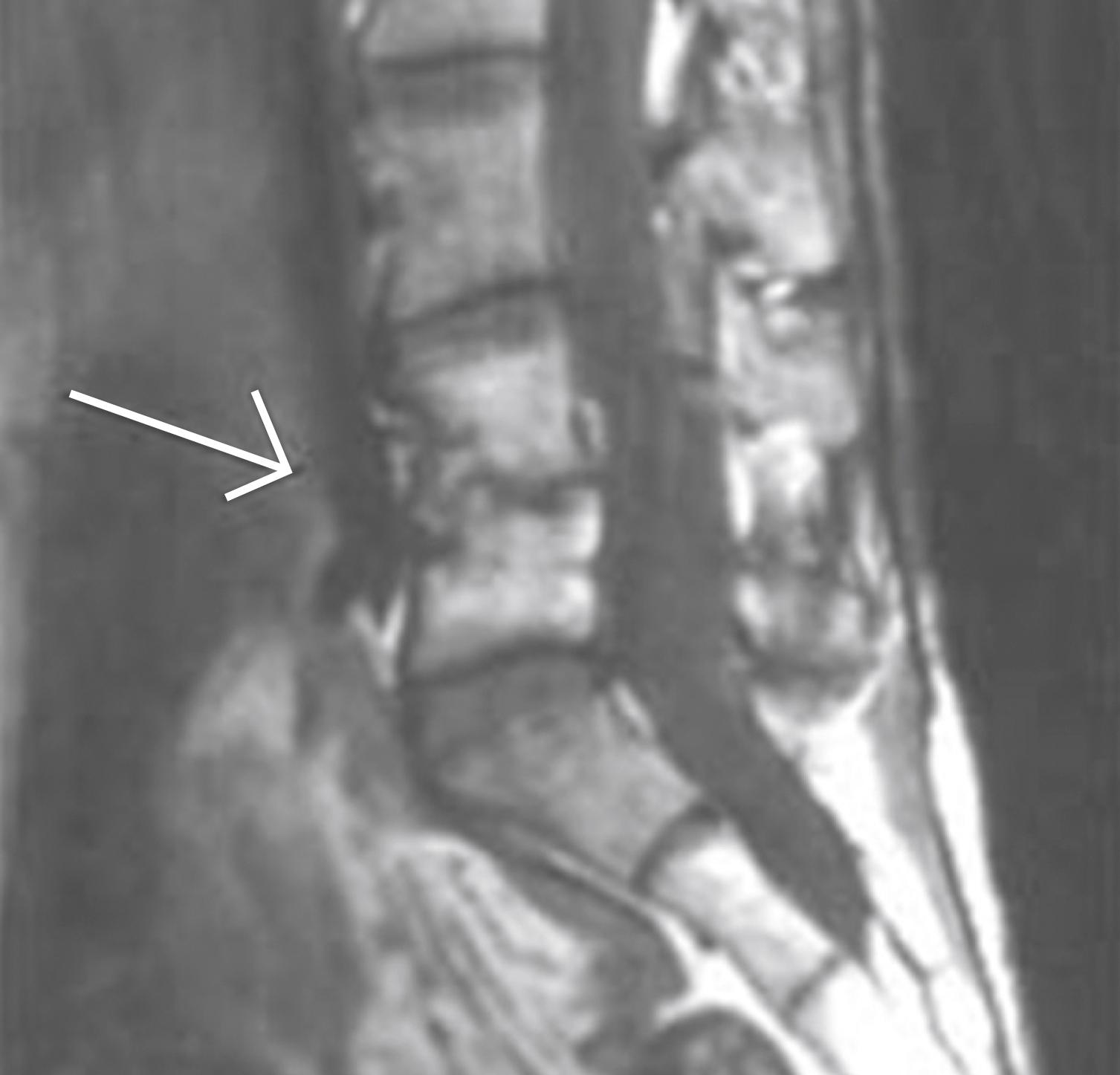
The treatment of spinal TB includes antitubercular therapy and bed rest in the initial period followed by braces, typically the ‘Taylor brace’ or anterior spinal hyperextension (ASH) brace for the thoracic spine. The sterno-occipito-mandibular immobilisation (SOMI) brace or four-post collar is used for the cervical spine and a Halo vest for craniovertebral TB. The healing in spinal TB occurs by fibrous or bony ankylosis. Usually, cold abscesses are not drained because they heal well with antitubercular drugs. A large cold abscess ( Fig. 28.11 ), however, may be aspirated or drained using an antigravity method to prevent formation of a nonhealing sinus tract. Pott paraplegia may require surgical debridement and spinal stabilisation.
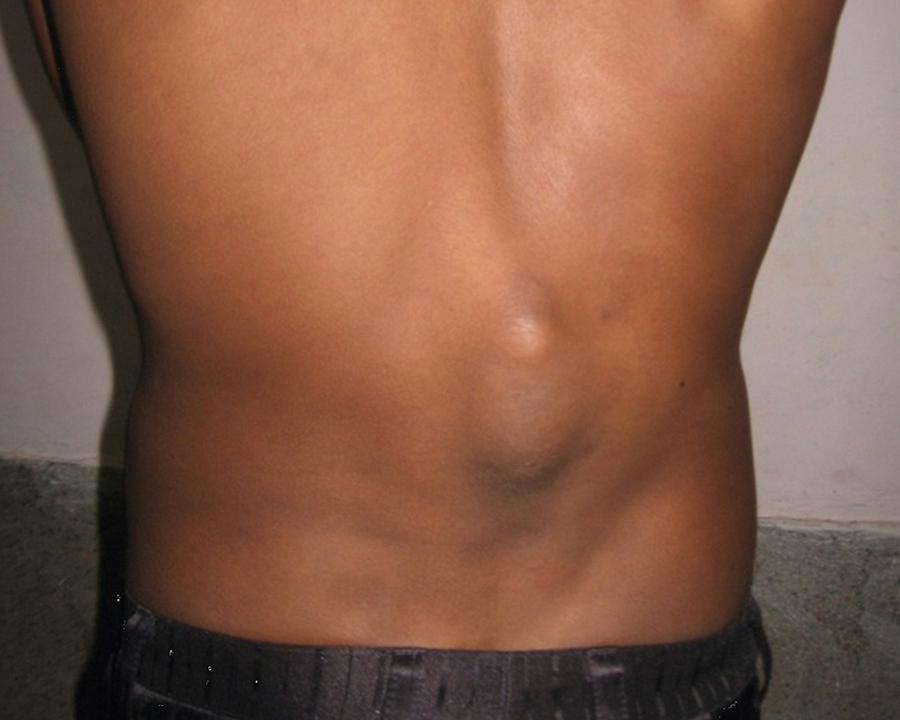
The hip is the most common large joint to be involved in TB. It has the following stages:
Stage of synovitis. The joint is swollen and distended to its maximum capacity, resulting in the typical attitude of flexion, abduction and external rotation of the joint with an apparent lengthening of the limb
Stage of early arthritis. Cavitation and destruction of the femoral head and acetabulum results in pain, spasm and night cries. The attitude of flexion, adduction and internal rotation is adopted by the patient with an apparent shortening of the limb. There is less than a centimetre of true shortening due to the destruction of the joint
Stage of late arthritis. Further destruction of the acetabulum results in a significant true shortening of the limb as the femoral head is pulled proximally into the damaged ‘migrating’ acetabulum ( Fig. 28.12 )
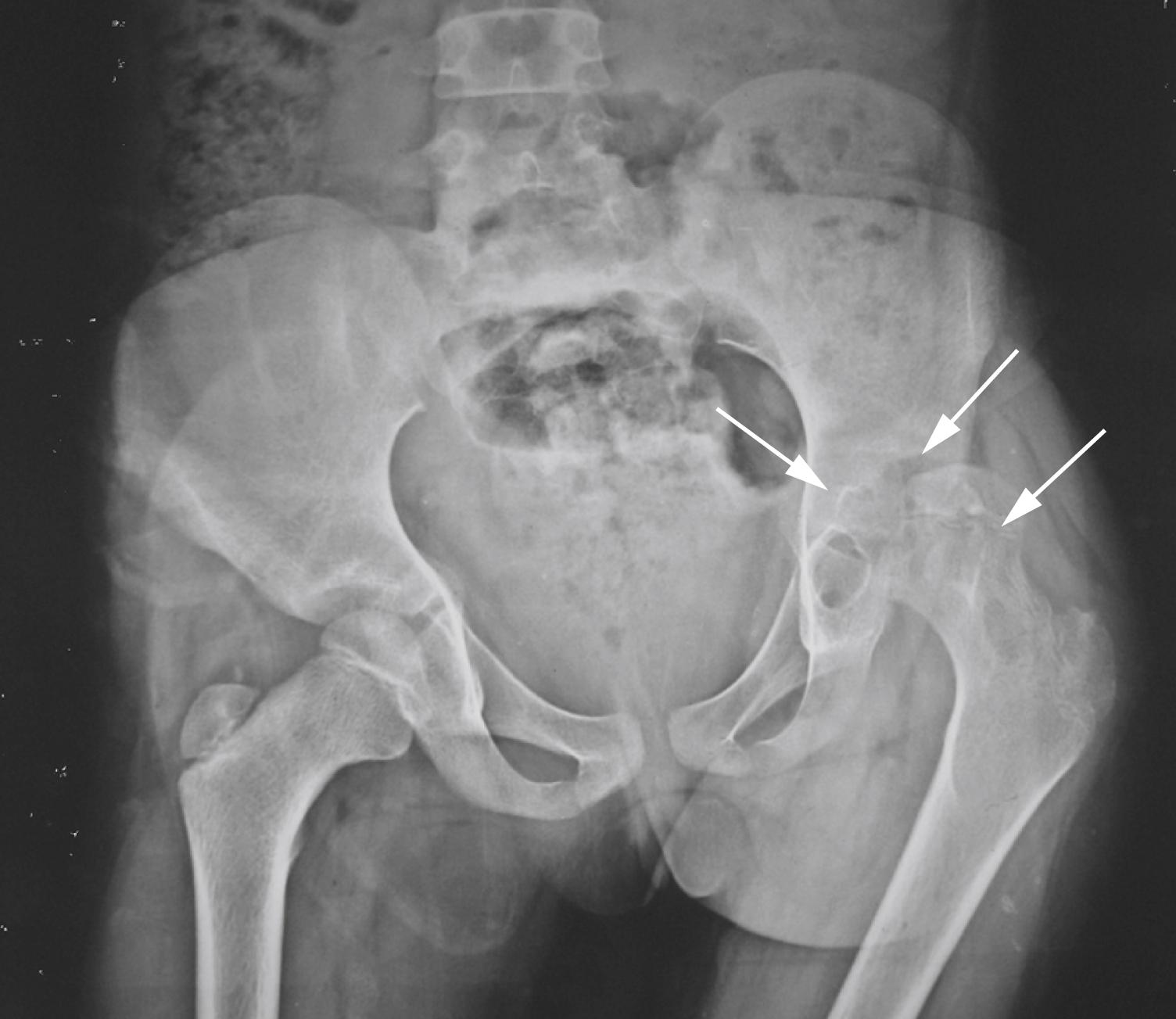
The treatment of hip TB includes antitubercular therapy along with traction of the hip to relieve the pain and correct the deformities. Healing occurs by fibrosis, resulting in fibrous ankylosis that permits only a minimum range of painful movements. Surgical treatment includes excisional arthroplasty or removal of the femoral head, which eventually results in a short limb but a painless mobile hip allowing patients to sit cross-legged or squat. Total hip replacement after adequate antitubercular therapy is becoming popular but has the risk of reactivation of the infection.
Become a Clinical Tree membership for Full access and enjoy Unlimited articles
If you are a member. Log in here